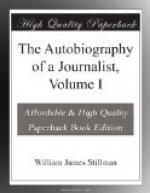Church in many respects was the most remarkable painter of the phenomena of nature I have ever known, and had he been trained in a school of wider scope, he might have taken a place amongst the great individualities of his art. But he had little imagination, and his technical training had not emancipated him from an exaggerated insistence on detail, which so completely controlled his treatment of his subject that breadth and repose were entirely lost sight of. A graceful composition, and most happy command of all the actual effects of the landscape which he had seen, were his highest qualities; his retention of the minutest details of the generic or specific characteristics of tree, rock, or cloud was unsurpassed by the work of any landscape painter whose work I know, and everything he knew he rendered with a rapidity and precision which were simply inconceivable by one who had not seen him at work. I think that his vision and retention of even the most transitory facts of nature passing before him must have been at the maximum of which the human mind is capable, but he had no comprehension of the higher and broader qualities of art. His mind seemed a camera obscura in which everything that passed before it was recorded permanently, but he added in the rendering of its record nothing which sprang from human emotion, or which involved that remoulding of the perception that makes it conception, and individual. The primrose on the river’s brim he saw with a vision as clear as that of a photographic lens, but it remained to him a primrose and nothing more to the end. All that he did or could do was the recording, form and color, of what had flitted past his eyes, with unsurpassed fidelity of memory; but it left one as cold as the painting of an iceberg. His recognition of art as distinguished from nature was far too rudimentary to fit him for a teacher, for his love of facts and detail blinded him to every other aspect of our relations with nature, in the recognition of which consist the highest gifts of the artist.
My study with Church lasted one winter, and showed me that nothing was to be hoped for from him, and that the most intimate superficial acquaintance with nature did not involve the perception of her more intimate relation with art. I learned from him nothing that was worth remembering, but I made acquaintance with a young portrait painter, who had a studio in the same building, an Irishman named Boyle, a pupil of Inman, whose ideas of art were of a far higher order, and to my intercourse with him during that winter and the following summer, which we spent together sketching in the valley of the Mohawk, I owe the first clear ideas of what lay before me in artist life. At Church’s studio I met Edgar A. Poe, a slender, nervous, vivacious, and extremely refined personage. But at that juncture I came across “Modern Painters,” and, like many others, wiser or otherwise, I received from it a stimulus to nature worship, to which I was




